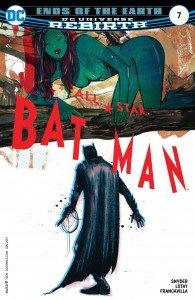 All-Star Batman #7 — Writer: Scott Snyder; Art/Colors (First story) — Tula Lotay; (Second story) — Francesco Francavilla
All-Star Batman #7 — Writer: Scott Snyder; Art/Colors (First story) — Tula Lotay; (Second story) — Francesco Francavilla
Detective Comics #950 — Writer: James Tynion IV; Art (First story) — Marcio Takara; Colors: Dean White; (Second story) — Pencils: Alvaro Martinez; Inks: Raul Fernandez; Colors: Brad Anderson; (Third story) — Pencils: Eddy Barrows; Inks: Eber Ferreira; Colors: Adriano Lucas
Action Comics #973 — Writer: Dan Jurgens; Pencils: Patch Zircher and Stephen Segovia; Inks: Patch Zircher and Art Thibert; Colors: Arif Prianto
Hal Jordan and the Green Lantern Corps #14 — Writer: Robert Venditti; Pencils: Rafa Sandoval; Inks: Jordi Tarragona; Colors: Tomeu Morey
Let’s start with the DC books this week — we don’t do that very often, but the “Rebirth” relaunches really do seem to be focusing on the core concepts that make 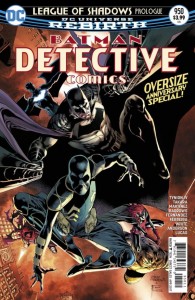 each character iconic and intriguing, and they’ve been hiring some skilled creators to help them do it. Witness All-Star Batman, where company mainstay Scott Snyder teams with up-and-coming artist Tula Lotay to present the Poison Ivy chapter of the current serial. Lotay (Supreme: Blue Rose) combines art and color to create a dreamy, detailed style that makes the Batman/Ivy combination dramatic, sexy and compelling, and the book’s high production values and glossy paper accentuate her art just right; she’s one of the few people who could hold her own with the art in the book’s back-up story, where Francesco Francavilla (Afterlife With Archie) and Snyder offer the middle chapter of a Riddler/Duke/Batman tale. The week’s other bat-book, Detective Comics, celebrates its 950th issue with an expanded page count — still at $3.99, too — that allows regular writer James Tynion IV to pair with three artists and focus on three sometimes-neglected characters: in the leadoff, he and Marcio Takara spotlight Cassandra Cain (with some Clayface, too), while in the second story Alvaro Martinez and Raul
each character iconic and intriguing, and they’ve been hiring some skilled creators to help them do it. Witness All-Star Batman, where company mainstay Scott Snyder teams with up-and-coming artist Tula Lotay to present the Poison Ivy chapter of the current serial. Lotay (Supreme: Blue Rose) combines art and color to create a dreamy, detailed style that makes the Batman/Ivy combination dramatic, sexy and compelling, and the book’s high production values and glossy paper accentuate her art just right; she’s one of the few people who could hold her own with the art in the book’s back-up story, where Francesco Francavilla (Afterlife With Archie) and Snyder offer the middle chapter of a Riddler/Duke/Batman tale. The week’s other bat-book, Detective Comics, celebrates its 950th issue with an expanded page count — still at $3.99, too — that allows regular writer James Tynion IV to pair with three artists and focus on three sometimes-neglected characters: in the leadoff, he and Marcio Takara spotlight Cassandra Cain (with some Clayface, too), while in the second story Alvaro Martinez and Raul 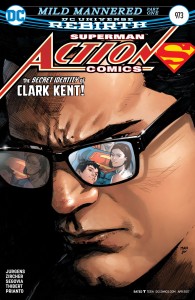 Fernandez feature Azrael and Batwing; the final story is only four pages, but offers some hints about the title’s arc for the coming year: Batman has a conversation with Tim Drake, before his disappearance, as Drake realizes that all of Bruce’s moves over the last year or two have been gearing up to mobilize against some looming disaster. Now we see why DC kept the comic relatively cheap: it’s an effective introduction to the Detective cast for new readers, and hopes to hook them with the dark-days-are-coming epilogue. There’s a similar energy over in the Superman titles, where, the new-52 versions of both Superman and Lois Lane having died, the married, older previous versions have taken over their jobs — except that, somehow, there’s a non-powered Clark Kent walking around, with no memory of ever having been a Man of Steel. Who is he, and how does he figure into the ways the characters’ universe has been changed and manipulated? That’s what this week’s new issue of Action begins to uncover, and old-pro writer Dan Jurgens manages both to make the characters and their problems appealing, and to give some weight to the story, with readers feeling
Fernandez feature Azrael and Batwing; the final story is only four pages, but offers some hints about the title’s arc for the coming year: Batman has a conversation with Tim Drake, before his disappearance, as Drake realizes that all of Bruce’s moves over the last year or two have been gearing up to mobilize against some looming disaster. Now we see why DC kept the comic relatively cheap: it’s an effective introduction to the Detective cast for new readers, and hopes to hook them with the dark-days-are-coming epilogue. There’s a similar energy over in the Superman titles, where, the new-52 versions of both Superman and Lois Lane having died, the married, older previous versions have taken over their jobs — except that, somehow, there’s a non-powered Clark Kent walking around, with no memory of ever having been a Man of Steel. Who is he, and how does he figure into the ways the characters’ universe has been changed and manipulated? That’s what this week’s new issue of Action begins to uncover, and old-pro writer Dan Jurgens manages both to make the characters and their problems appealing, and to give some weight to the story, with readers feeling 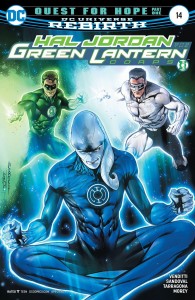 like the events are important to the overall DC universe. Green Lantern, of course, is the most universe-spanning of all the comics, and Hal Jordan and the Green Lantern Corps, its earlier issues having gotten all of the familiar Earther ring-bearers — Jordan, Guy Gardner, Kyle Raynor and John Stewart — together, is now combining them with aliens both old and new, and teaming them with what’s left of a scattered Sinestro Corps to deal with looming cosmic threats. It’s fast-paced, colorful sf, just what’s always attracted readers of this title, and the creative team so far has done a good job of roping them in and keeping them hooked: exactly the point of “Rebirth,” after all.
like the events are important to the overall DC universe. Green Lantern, of course, is the most universe-spanning of all the comics, and Hal Jordan and the Green Lantern Corps, its earlier issues having gotten all of the familiar Earther ring-bearers — Jordan, Guy Gardner, Kyle Raynor and John Stewart — together, is now combining them with aliens both old and new, and teaming them with what’s left of a scattered Sinestro Corps to deal with looming cosmic threats. It’s fast-paced, colorful sf, just what’s always attracted readers of this title, and the creative team so far has done a good job of roping them in and keeping them hooked: exactly the point of “Rebirth,” after all.
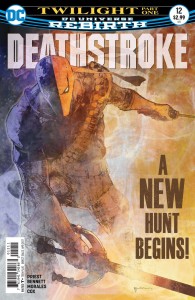 Deathstroke #12 — Writer: Christopher Priest; Breakdowns: Larry Hama; Pencils: Joe Bennett; Inks: Mark Morales; Colors: Jeromy Cox
Deathstroke #12 — Writer: Christopher Priest; Breakdowns: Larry Hama; Pencils: Joe Bennett; Inks: Mark Morales; Colors: Jeromy Cox
Justice League of America: Rebirth #1 (of 1) — Writer: Steve Orlando; Pencils: Ivan Reis; Inks: Joe Prado and Oclair Albert; Colors: Marcelo Maiolo
Justice League/Mighty Morphin Power Rangers #2 (of 6) — Writer: Tom Taylor; Art/Colors: Stephen Byrne
 Titans #8 — Writer: Dan Abnett; Pencils: Brett Booth; Inks: Norm Rapmund; Colors: Andrew Dalhouse
Titans #8 — Writer: Dan Abnett; Pencils: Brett Booth; Inks: Norm Rapmund; Colors: Andrew Dalhouse
Deathstroke‘s worth a look because Christopher Priest is a very very smart writer, with a unique style using black-screen title cards to divide the story into scenes of between two and seven or eight pages; he can label the title cards with the setting and time, leaving him free to jump around in the narrative and still have readers keep up, and he’s had decades to hone it into an effective storytelling device. Bennett and Morales are solid on the conversational stuff, 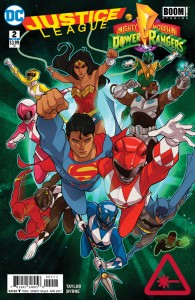 and the costumed-fight scenes pop off the page, thanks to striking design and Jeromy Cox’s bold coloring. You should pick up the last few of these from the stands and see if it doesn’t become an addiction. The Justice League franchise offers the origin of the new ongoing Justice League of America, which looks like a Batman and the Outsiders with Black Canary and Vixen trying to help corral classic-biker Lobo (courtesy of Justice League vs Suicide Squad) and bad-girl-trying-to-be-good Killer Frost, while mentoring rookies the Ray and the Ryan Choi Atom. Worth it for the Batman/Lobo scenes, one in particular. Justice League/Power Rangers #2 starts with a big splashy cool (if
and the costumed-fight scenes pop off the page, thanks to striking design and Jeromy Cox’s bold coloring. You should pick up the last few of these from the stands and see if it doesn’t become an addiction. The Justice League franchise offers the origin of the new ongoing Justice League of America, which looks like a Batman and the Outsiders with Black Canary and Vixen trying to help corral classic-biker Lobo (courtesy of Justice League vs Suicide Squad) and bad-girl-trying-to-be-good Killer Frost, while mentoring rookies the Ray and the Ryan Choi Atom. Worth it for the Batman/Lobo scenes, one in particular. Justice League/Power Rangers #2 starts with a big splashy cool (if 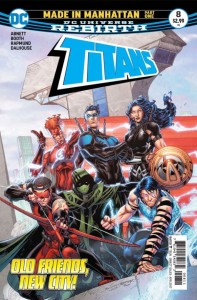 lopsided) fight between those two teams, followed by detente and realization of a common enemy — standard stuff, but colorful and fun, especially for members of the Power Ranger generation. Titans continues to be a brisk combination of nostalgia, with its Dick/Speedy/Diana/Wally/ core (and callbacks this issue to characters like Mal Duncan and Bumblebee), and deep connection to the ongoing what-happened-to-the-D.C.-universe meta-story; this issue’s light on the latter but effective on the former, and if you were reading Teen Titans about the time you were watching those Power Rangers cartoons, you’ll probably like this a lot too.
lopsided) fight between those two teams, followed by detente and realization of a common enemy — standard stuff, but colorful and fun, especially for members of the Power Ranger generation. Titans continues to be a brisk combination of nostalgia, with its Dick/Speedy/Diana/Wally/ core (and callbacks this issue to characters like Mal Duncan and Bumblebee), and deep connection to the ongoing what-happened-to-the-D.C.-universe meta-story; this issue’s light on the latter but effective on the former, and if you were reading Teen Titans about the time you were watching those Power Rangers cartoons, you’ll probably like this a lot too.
 Jessica Jones #5 — Writer: Brian Michael Bendis; Art: Michael Gaydos; Colors: Matt Hollingsworth
Jessica Jones #5 — Writer: Brian Michael Bendis; Art: Michael Gaydos; Colors: Matt Hollingsworth
Guardians of the Galaxy #17 — Writer: Brian Michael Bendis; Art: Valerio Schiti; Colors: Richard Isanove
Black Widow #11 — Writers: Chris Samnee and Mark Waid; Art: Chris Samnee; Colors: Matthew Wilson
The Unbeatable Squirrel Girl #17 — Writer: Ryan North; Art: Erica Henderson; Colors: Rico Renzi
 Ms. Marvel #15 — Writer: G. Willow Wilson; Art: Takeshi Miyazawa; Colors: Ian Herring
Ms. Marvel #15 — Writer: G. Willow Wilson; Art: Takeshi Miyazawa; Colors: Ian Herring
As so often with Marvel lately, it’s the books about the women that are the most interesting. Jessica Jones is moving to the climax of its first arc, with her original creators doing just as well by her as they did back in her Alias days; the shadowy moral dilemmas (we’re never quite sure if she’ll do the right thing), screwed-up private life, weird superhero-related private-investigator cases, and shadow-drenched street-level noirish art should make this attractive to both older fans and newer ones 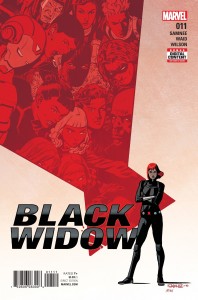 brought in by the Netflix show. If you don’t always like Bendis, try this book: it’s the kind of police procedural/spandex mashup he started out with in Powers, and shows his writing at its best. Guardians of the Galaxy is also Bendis, but in full superhero mode; with the GOTG stranded on Earth, he’s been offering a series where each issue spotlights one member of the team, and this issue it’s Gamora, who, having found out Thanos is on Earth, want to go kill him, and runs afoul of the heroic community, especially the Ultimates and Alpha Flight. Decent for GOTG fans, and there are a couple of good scenes with Captain Marvel (whom Bendis covered so thoroughly in
brought in by the Netflix show. If you don’t always like Bendis, try this book: it’s the kind of police procedural/spandex mashup he started out with in Powers, and shows his writing at its best. Guardians of the Galaxy is also Bendis, but in full superhero mode; with the GOTG stranded on Earth, he’s been offering a series where each issue spotlights one member of the team, and this issue it’s Gamora, who, having found out Thanos is on Earth, want to go kill him, and runs afoul of the heroic community, especially the Ultimates and Alpha Flight. Decent for GOTG fans, and there are a couple of good scenes with Captain Marvel (whom Bendis covered so thoroughly in 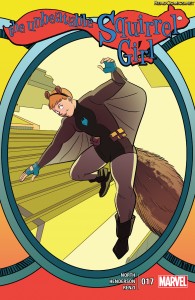 Civil Wars II) that are worth your time. Black Widow sees Natasha trying to keep six young girls, trained as she was, from starting a world war, while not killing them; as the penultimate issue of the book’s second arc, it’s all action, and as choreographed by Samnee and Waid it’s crystal-clear, dynamically composed and beautifully drawn. This is very different from their shiny, optimistic Daredevil, but just as high-quality. Squirrel Girl, often the best book on the stands, starts a new story, and everything in it, from our heroine’s meeting a new mentor who suggests a new power for her (an eminently logical one, as the Superman-tribute cover reveals), to a fight with The Rhino that’s resolved in typically-Doreen
Civil Wars II) that are worth your time. Black Widow sees Natasha trying to keep six young girls, trained as she was, from starting a world war, while not killing them; as the penultimate issue of the book’s second arc, it’s all action, and as choreographed by Samnee and Waid it’s crystal-clear, dynamically composed and beautifully drawn. This is very different from their shiny, optimistic Daredevil, but just as high-quality. Squirrel Girl, often the best book on the stands, starts a new story, and everything in it, from our heroine’s meeting a new mentor who suggests a new power for her (an eminently logical one, as the Superman-tribute cover reveals), to a fight with The Rhino that’s resolved in typically-Doreen 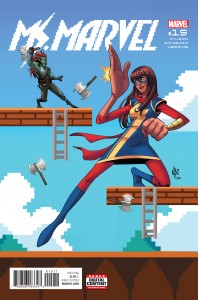 fashion, to the twist at the end (not to mention the bear/rooster fight) makes me smile; I hope this book, by this creative team, goes on forever. Ms. Marvel has been a good comic for quite a while, too, and is in the middle of a serial about Kamala fighting an Internet stalker who knows her identity. That allows for a number of smart themes involving trolling, shaming, and why being anonymous makes people mean, all of which should resonate with the book’s YA audience — and, come to think of it, the rest of us, too — while still providing a colorful, action-filled story with appealing characters: exactly why this is such a good comic.
fashion, to the twist at the end (not to mention the bear/rooster fight) makes me smile; I hope this book, by this creative team, goes on forever. Ms. Marvel has been a good comic for quite a while, too, and is in the middle of a serial about Kamala fighting an Internet stalker who knows her identity. That allows for a number of smart themes involving trolling, shaming, and why being anonymous makes people mean, all of which should resonate with the book’s YA audience — and, come to think of it, the rest of us, too — while still providing a colorful, action-filled story with appealing characters: exactly why this is such a good comic.
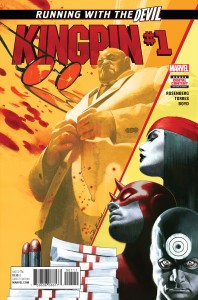 Kingpin #1 — Writer: Matthew Rosenberg; Art: Ben Torres; Colors: Jordan Boyd
Kingpin #1 — Writer: Matthew Rosenberg; Art: Ben Torres; Colors: Jordan Boyd
The Unworthy Thor #4 (of 5) — Writer: Jason Aaron; Art: Olivier Coipel with Kim Jacinto; Frazer Irving; Esad Ribic; Russell Dauterman; Colors: Matthew Wilson, Matt Milla and Frazer Irving
Inhumans vs X-Men #4 (of 6) — Writers: Jeff Lemire and Charles Soule; Art: Javier Garron; Colors: David Curiel
Kingpin #1 offers a decent-enough look at the corpulent crimeboss, using as the viewpoint character a woman reporter whom Fisk is trying to cajole into writing his biography; despite their presence on the cover, no costumed heroes show up 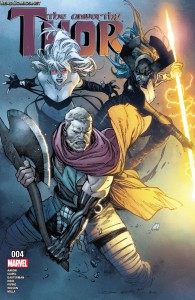 (although Matt Murdock does, for a page or two). Torres seems to be channeling early Frank Miller on the art, which of course is appropriate, and while the story is pretty standard stuff (this could just as easily be a Lex Luthor/Lois Lane story, as we get scenes of the title character working out with unfortunate sparring partners, rubbing elbows with the rich and famous, acting civilized with the reporter and then less so when she’s gone, etc. ), there’s enough to bring readers back for a second issue. Unworthy Thor involves the Odinson and Beta Ray Bill fighting the Collector and a couple of Thanos minions for the Ultimate Universe Thor’s hammer: a great big slugfest, intercut with flashbacks (drawn by former Thor artists Irving, Ribic and Dauterman) that help to fill us in
(although Matt Murdock does, for a page or two). Torres seems to be channeling early Frank Miller on the art, which of course is appropriate, and while the story is pretty standard stuff (this could just as easily be a Lex Luthor/Lois Lane story, as we get scenes of the title character working out with unfortunate sparring partners, rubbing elbows with the rich and famous, acting civilized with the reporter and then less so when she’s gone, etc. ), there’s enough to bring readers back for a second issue. Unworthy Thor involves the Odinson and Beta Ray Bill fighting the Collector and a couple of Thanos minions for the Ultimate Universe Thor’s hammer: a great big slugfest, intercut with flashbacks (drawn by former Thor artists Irving, Ribic and Dauterman) that help to fill us in 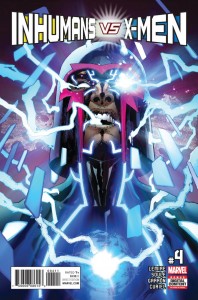 on his long history with Mjolnir; there’s plenty of nicely-drawn action, and with Aaron scripting, it’s a close companion piece to the main Mighty Thor comic, one fans of that book should definitely be reading. That leaves Inhumans vs X-Men, as the former try to break out of limbo, Mosaic does some spying, and the few newly-minted Inhumans on the outside (including Ms. Marvel and Moon Girl) start to get a clue that maybe, just maybe, the conflict isn’t as black-and-white as they assumed: in other words, about where you’d expect things to be in part four of a six-part story (I’m reserving judgment until I see how well Lemire and Soule stick the landing on this…).
on his long history with Mjolnir; there’s plenty of nicely-drawn action, and with Aaron scripting, it’s a close companion piece to the main Mighty Thor comic, one fans of that book should definitely be reading. That leaves Inhumans vs X-Men, as the former try to break out of limbo, Mosaic does some spying, and the few newly-minted Inhumans on the outside (including Ms. Marvel and Moon Girl) start to get a clue that maybe, just maybe, the conflict isn’t as black-and-white as they assumed: in other words, about where you’d expect things to be in part four of a six-part story (I’m reserving judgment until I see how well Lemire and Soule stick the landing on this…).
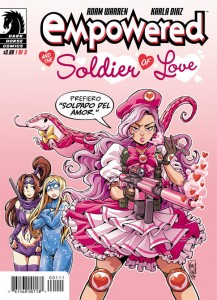 Empowered and the Soldiers of Love #1 (of 3) — Story: Adam Warren; Art/Colors: Karla Diaz
Empowered and the Soldiers of Love #1 (of 3) — Story: Adam Warren; Art/Colors: Karla Diaz
John Carter: The End #1 — Writers: Brian Wood and Alex Cox; Art: Hayden Sherman; Colors: Chris O’Halloran
Red Sonya #2 — Writer: Amy Chu; Art: Carlos Gomez; Colors: Mohan
Of the newer indy titles, Empowered, which comes out much less often than it should, begins a new, appropriately-themed Valentine’s-Day mini-series, the first of three parts, as a Cupid-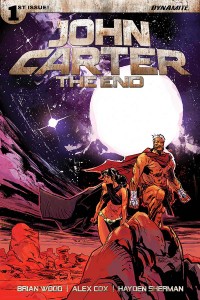 like villain comes to town and creates chaos by messing with everyone’s romantic entanglements. Chilean artist Karla Diaz does a wonderful job melding her style with Warren’s (they’re both on the light-hearted manga end of the spectrum, and when in the editorial material he refers to her “energetically cartoony artistic sensibility,” he gets it just right), and the result is a fun, often funny, take on a superhero universe that’s only slightly more cockeyed than the Marvel and DC ones. John Carter: The End, as its title suggests, is all seriousness, and set in the far future, as an estranged Carter and Dejah Thoris have to reunite and rescue Barsoom from a dictator with a particularly close relationship to them; the art’s OK,
like villain comes to town and creates chaos by messing with everyone’s romantic entanglements. Chilean artist Karla Diaz does a wonderful job melding her style with Warren’s (they’re both on the light-hearted manga end of the spectrum, and when in the editorial material he refers to her “energetically cartoony artistic sensibility,” he gets it just right), and the result is a fun, often funny, take on a superhero universe that’s only slightly more cockeyed than the Marvel and DC ones. John Carter: The End, as its title suggests, is all seriousness, and set in the far future, as an estranged Carter and Dejah Thoris have to reunite and rescue Barsoom from a dictator with a particularly close relationship to them; the art’s OK, 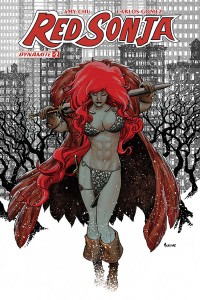 but it’s the Brian Wood scripting that really drives the story — as his run on the pre-Disney, Dark Horse Star Wars showed, he’s very good at finding the core attraction of established properties, and setting them off on high-stakes, interesting adventures. So too for the new Red Sonya volume, as the Hyborean redhead has been somehow transported to modern-day New York City, courtesy of old enemy Kulan Gath; that’s not a new dilemma for her (see Marvel Team-Up #79), but it’s one that offers a lot of fascinating fish-out-of-water opportunities, and so far is keeping my interest: not many modern versions of the character have been able to do that.
but it’s the Brian Wood scripting that really drives the story — as his run on the pre-Disney, Dark Horse Star Wars showed, he’s very good at finding the core attraction of established properties, and setting them off on high-stakes, interesting adventures. So too for the new Red Sonya volume, as the Hyborean redhead has been somehow transported to modern-day New York City, courtesy of old enemy Kulan Gath; that’s not a new dilemma for her (see Marvel Team-Up #79), but it’s one that offers a lot of fascinating fish-out-of-water opportunities, and so far is keeping my interest: not many modern versions of the character have been able to do that.
 Moonshine #5 — Writer: Brian Azzarello; Art/Colors: Eduardo Risso; Color Assistant: Christian Rossi
Moonshine #5 — Writer: Brian Azzarello; Art/Colors: Eduardo Risso; Color Assistant: Christian Rossi
The Wicked and the Divine #26 — Writer: Kieron Gillen; Art: Jamie McKelvie; Colors: Matthew Wilson
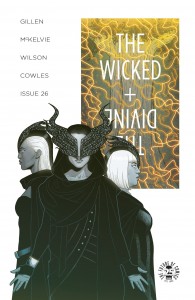 War Stories #22 — Writer: Garth Ennis; Art: Tomas Aira; Colors: Digikore Studios
War Stories #22 — Writer: Garth Ennis; Art: Tomas Aira; Colors: Digikore Studios
World of Tanks #5 (of 5) — Writer: Garth Ennis; Art: P.J. Holden; Colors: Michael Atiyeh
Eduardo Risso drawing moonshiners and ’20s  gangsters and werewolves is reason enough to read Moonshine (sadly, it took until this fifth issue to realize that the title refers to the alcohol and the werewolves…). Kieron Gillen and Jamie McKelvie (and colorist Matthew Wilson, whose rich palette gets him jobs on all the cool books) make The Wicked and the Divine essential, especially if you’ve been following them since Phonogram and Young
gangsters and werewolves is reason enough to read Moonshine (sadly, it took until this fifth issue to realize that the title refers to the alcohol and the werewolves…). Kieron Gillen and Jamie McKelvie (and colorist Matthew Wilson, whose rich palette gets him jobs on all the cool books) make The Wicked and the Divine essential, especially if you’ve been following them since Phonogram and Young 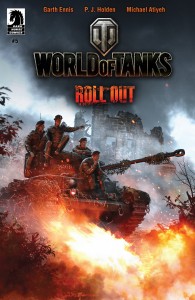 Avengers. Finally, this week sees two Garth Ennis war comics: the regular book, War Stories, concludes a tale about the British air fighters who defended England from the Nazis during WWII, while World of Tanks concludes a mini-series (based on the online war game) about a British tank crew in Normandy in 1944, a few months after D-Day, fighting a German tank crew who’s just as well-conceived and sympathetic as they are. Both comics are ends, not beginnings, so back up and get the earlier issues and read them together; Ennis war comics are always worth it.
Avengers. Finally, this week sees two Garth Ennis war comics: the regular book, War Stories, concludes a tale about the British air fighters who defended England from the Nazis during WWII, while World of Tanks concludes a mini-series (based on the online war game) about a British tank crew in Normandy in 1944, a few months after D-Day, fighting a German tank crew who’s just as well-conceived and sympathetic as they are. Both comics are ends, not beginnings, so back up and get the earlier issues and read them together; Ennis war comics are always worth it.



